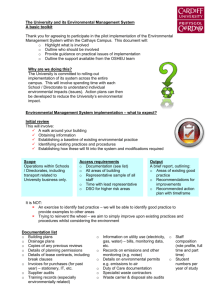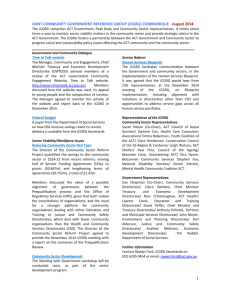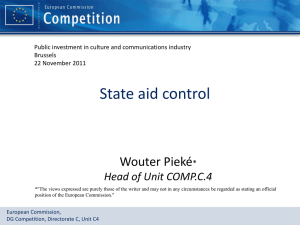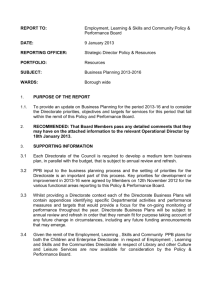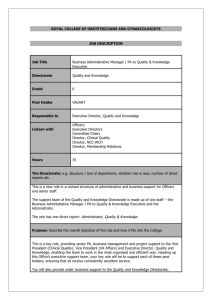LPH_1331702268
advertisement
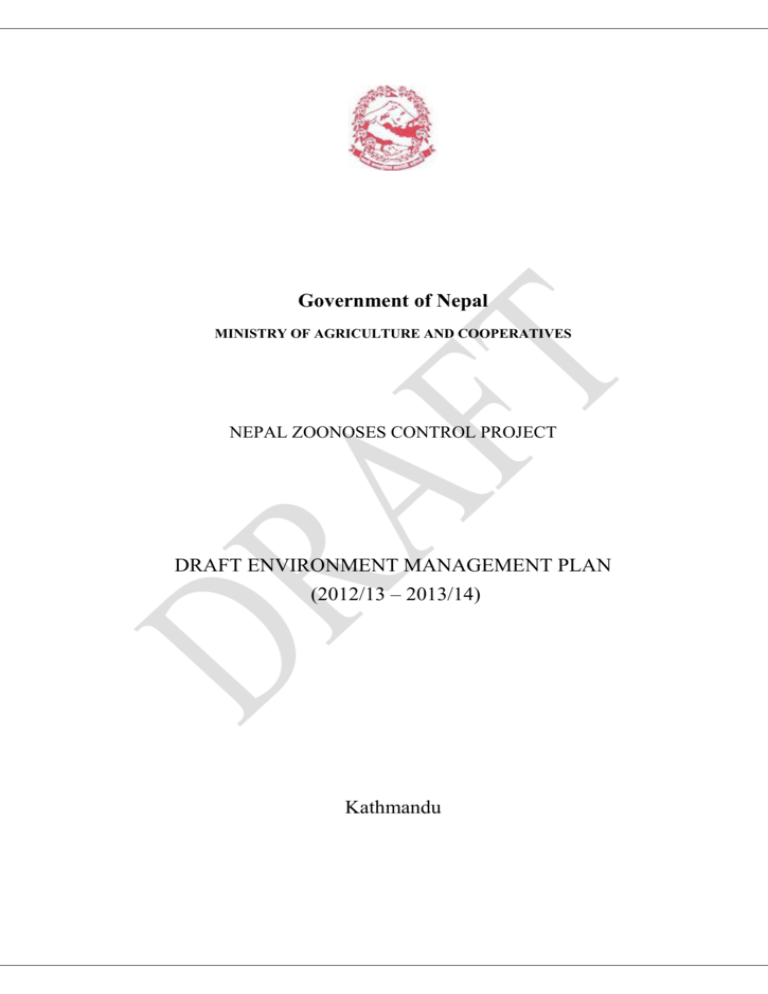
Government of Nepal MINISTRY OF AGRICULTURE AND COOPERATIVES NEPAL ZOONOSES CONTROL PROJECT DRAFT ENVIRONMENT MANAGEMENT PLAN (2012/13 – 2013/14) Kathmandu ENVIRONMENT MANAGEMENT PLAN Background Outbreak of highly pathogenic emerging disease (HPED) caused by the infectious disease had been spreading across the globe since 2003. Nepal also recorded eleven outbreak of HPAI in 2009 to till now. Therefore, the country is at high risk, with the disease outbreak recorded in China to the north and in India to the south. In addition Nepal is on two routes for migratory birds, which are known to be carriers of the disease. The Nepal Zoonoses Control Project aims to minimize the threat posed by HPED to humans in Nepal by: i) controlling such infections among birds, especially domestic poultry and ii) preparing for, controlling, and responding to possible human infections, especially an influenza epidemic and related emergencies. The Project envisages three types of interventions: i) prevention, ii) preparedness and planning, and iii) response and containment in case of AI outbreaks. The Project has four main components- 1. 2. 3. 5. Institutional Capacity Capacity building delivery, dissemination Animal Market Information and Communication 4. This Environmental Management Plan (EMP) covers, the Environmental Impact Assessment of Institutional Capacity, Capacity building delivery, dissemination, Animal Market, Information and Communication. This project is unlikely to cause any adverse environmental impacts. Activities under Animal Health Component: Institutional Capacity, Capacity building delivery dissemination, Animal Market Information and Information Communication There is a compensation fund in case of a stamping out operation to assist poultry owners for loss of assets caused by mandatory culling of their birds. 1. Policy and Legal Framework The Government of Nepal (GoN) has prepared strategic plan, “National Avian Influenza Control and Influenza Pandemic Preparedness and Response Plan (NAIIPPRP)” with the objective of protecting people and livestock against future outbreaks of AI within Nepal border. This plan has been build on the National Contingency Plan for Highly Pathogenic Avian Influenza that was in place since 2004. And the government of Nepal will prepare strategic plan for Other HPED (FMD, PPR, CSF and meat borne zoonoses). The Animal Health and Livestock Services Act 1998, the Slaughterhouse and Meat Inspection Act 1999 and the Nepal Veterinary Council Act 1999 are the three acts relevant to the livestock sector. These acts and their rules made provisions and define procedures relating to animal quarantine, regulating slaughter of animals and sale of meat, disposal of animal or products of animal origin or livestock product materials, disease information, disinfection, etc. For example, the Animal Health and Livestock Services Regulation 1999 requires that any animal, products of animal origin or livestock product materials be either burnt or buried in 3 feet deep pit or disposed of in accordance with the procedures set forth by the Department. The dead body of an animal should be disposed of so as not to causing spread of disease and the vehicle transporting such animal shall have to be disinfected. The Department of Livestock Services has issued the Hatchery Standard: the standard also includes code of practice and defines requirements for hatchery building, sanitation, and biosecurity. The Environmental Protection Act (EPA) 1997 and Environmental Protection Rules (EPR) 1997 define when environmental study is required, including procedures for undertaking such study. According to the Environmental Protection Rules 1997 establishing a farm for 2000 to 5000 domestic fowl require Initial Environmental Examination (IEE) and an Environmental Impact Assessment (EIA) is necessary if the number exceeds 5000. Importing, sale, supply, storage, disposal and use of substances defined by the government as toxic require environmental studies if these exceeds certain threshold: for example, an IEE is required for storage of 100 kg to 1 ton of toxic substances. The strategic plan, acts and regulations, and standard provides basic legal framework for environmental management in the Nepal Zoonoses Control Project. The implementation/ enforcement of the regulatory provisions have been generally weak, basically due to capacity constraints, weak monitoring and inadequacy or lack of details in the provisions. The GoN has already prepared a Guideline for Investigation, Prevention and Control of Bird Flu (Highly Pathogenic Avian Influenza): this explains standard operating procedures (SOP) for investigation, prevention and control of bird flu and will prepared similar documents of FMD, PPR and meat borne disease. This is much more detailed than the provisions made in the rules, and adapts relevant international / neighbouring countries experiences. 2. Potential Environmental Impact Most activities proposed under the Nepal Zoonoses Control Project, like its similar predecessor the Avian Influenza Control Project, are likely to have limited adverse environmental impacts as they are designed to enhance capacity of relevant agencies, help better prepared for timely detection and dealing with HPED outbreaks in poultry, hygienic meat production and raise stakeholders’ awareness regarding AI. Although project activities/ interventions are focused to AI, these are expected to indirectly contribute in improving sanitation in poultry farming, waste-management at poultry farm unit as well as laboratories, pollution control, and controlling infectious diseases because of increased awareness and enhanced capacity. Environmental safeguards are mainstreamed in the Standard Operating Procedures (SOP) for the project: these will not only ensure implementation of environmental measures in the project, but are likely to positively influence environmental practices and performance in the sector in general. All these are likely to result improved environmental management in the sector and hence positive environmental impacts in the long-run. Minor adverse environmental impacts may result from the construction activities, collection of samples/ specimen, laboratory wastes and setting up of sentinel outpost: these can easily be mitigated by simple measures recommended in following Table. Significant adverse environmental impacts, however, may occur during emergency operation activities for containment of HPED outbreaks basically from inappropriate culling and transportation of infected and at-risk birds, disposal of carcasses, and use of chemicals for disinfection. Following are the main risks and concerns, if appropriate mitigation measures are not in-place; Risk of human exposure and spread of HPED due to: improper culling and disposal of dead bird; lack of or improper use of personal protection equipment (PPE); improper disposal of farm waste; and inadequate laboratory bio-safety protocols. Release of chemicals in the environment and risk of human exposure/ intoxication in the process of disinfection; Release of chemicals and infectious agents into the environment and risk of human exposure from inadequate laboratory waste management; Water and air pollution risks from disposal of carcasses, farm waste, and laboratory waste, etc. The identified environmental impacts of the project could be avoided or minimized to acceptable level by integrating environmental and public health safety aspects in the design and implementation of activities. Training on these measures and monitoring the preparation as well as enforcement are critical in order to ensure effective implementation of the recommended measures. 3. Environmental Management Plan to Mitigate Potential Adverse Impacts of the Nepal Zoonoses Control Project. Animal Health Component Project activity Potential impact / issue Mitigation measures Air Pollution, noise pollution effect in human health, socio impact and increased amount of wastes generated at the construction. Follow internationally accepted to control air pollution, noise pollution, human health and social effect. Insurance of involve manpower, Waste treatment and management practices. Follow standard construction practices as prescribed in the Public Works Directives Mitigation, Monitoring and Supervision Responsibility 1. Institutional Capacity This includes the construction of Quarantine buildings, Warehouse and service centre. a. Renovation and refurbishing of existing physical infrastructure facilities of exiting Public health Offices, DLSO and government Poultry breeding farms. minor impacts such as noise, dust, sanitation, etc due to limited construction activities Follow standard construction practices as prescribed in the Public Works Directives. DLS concern authority to ensure appropriate waste management facilities and practices. Project coordination unit checks and ensures that the pollution waste management plan is included in the construction and refurbishing plan of the Quarantine buildings, ware house and service centre. Animal Health Directorate and Regional Directorate monitor the pollution control management practices in the concern offices of their respective jurisdictions. Construction Supervision team ensures compliance with the Public Works Directives by the contractor. 5 2. Capacity building delivery dissemination 2.1 Surveillance and epidemiological investigation a. Collection of samples Sampling team at risk of specimens from backyard exposure to infection poultry, organized poultry farm and sentinel birds (samples or specimen would include blood – serum samples as well as tracheal and cloacae swabs) Increased load / samples at laboratories and increased amount of laboratory wastes generation lead to increased risk of pollution and infections - haphazard disposal of syringe/ needle / swap etc. - Chemical disinfection of certain sampling items such as globes. - Transportation of infected samples Pollution and crosscontamination In normal case, wear generally prescribed safety items such as mask, globe and other. Sampling from the area identified as high AI risk, use SOP prescribed procedures and measures. Train staff. DLSO supervise and ensure that safety procedure fully followed. Appropriate laboratory waste management practices (see 1.3 also) Concerned laboratory authority ensures that proper waste system is in-place and waste is managed properly. Disinfect and burn these items in appropriate chamber or bury in a pit. Animal Health Directorate checks randomly the availability of safety gear and use of safety procedures during sampling (once every six month). Animal Health directorate checks every six month waste management practices in all laboratories. DLSO supervise and ensure implementation of the mitigation. Animal Health Directorate monitors the practices randomly (once every six month). - do- Chemical pollution and human Use only the safe/ prescribed chemical in exposure to chemicalsprescribed amount only by trained person. intoxication and burn. Risk of disease transmission Use only healthy, disease free bird as sentinel from sentinel bird to wild bird, bird or vice versa. SOP to be applied to AI infected sentinel bird (s) in same way as infected domestic bird. Risk of virus spreading and Collection transport in closed containers that exposure of personnel do not leak or release air emissions Only use trained and certified personnel that -do- Sampling team under supervision of DLSO implements mitigations Regional Directorate checks/ monitors / 6 have access to and use the recommended protective gear Only use personnel that have been vaccinated. b. Participatory disease intelligence - Using Animal Health Workers and farmers as communication channel for disease intelligence c. Capacity building of veterinary, Para Professional and farmers for surveillance and biosafety training, hygienic meat production training workshops on sero-sampling, PPE, and prevention, control and containment of HPED. Disease spreading risk while transporting live or dead bird samples to LSDC or designated place by VAHW/ farmer. Training not only on reporting bird mortality and sickness, but also on safety procedure to be followed if they bring bird samples. No negative environmental impacts. This will also increase the capacity of the veterinary, Para professional and Farmers in managing environmental impacts and concerns. Training also to include relevant environmental management measures recommended in this EMP. verifies availability of containers and protective gear. Randomly checks proper use of these. District Health Office monitors health status/ record of the personnel involved. (six monthly) VAHW supervise farmers. DLSO checks/ monitors regularly Directorate of Livestock Services and Communication ensure inclusion of environmental safeguards in training course. Animal Health Directorate checks the course before training is organized and visits random samples of training events. 2.2 Strengthening animal quarantine b. Transportation/ communication facilities, and host of equipments such as chilling and fumigating equipments, sprayers, etc No potential adverse impacts. (see 1.4b for potential impacts from use of chemicals) (see 1.4b for mitigation of potential impacts from use of chemicals) Project Coordination Unit to plan and purchase and made available equipments in time. Animal Health Directorate to check procurement plan and availability of communication facility and equipment. 7 2.3 Strengthening veterinary services and Avian Influenza Control and Containment Plan a. Disease emergency response - formation of Rapid No adverse impacts. Training Training should also include key environmental Response Teams (RRTs) can enhance RRTs issues and appropriate ways to manage the -Training and equipping environmental management environmental impacts/ concerns. RRTs on HPED Control and capacity during control and outbreak Containment containment operations. Operation. - stocking of chemicals in outbreak of HPED situation. Chemical intoxication and burns, accidents. b. HPED Control and Outbreak Containment Operation Collection and disposal of Risk of spreading the virus and infected dead birds exposure of personnel. Culling of birds Risk of intoxication when using chemical for culling Stress, heat and fatigue from working in PPE Distress to residents, farmers and owners (particularly children) observing on-site culling of their birds Follow standard stocking practice. Environmental Protection Rule requires environmental study for storage, use and disposal of defined/ notified toxic substances in quantity exceeding 100 kg. Directorate of Livestock Services and Communication ensure inclusion of environmental safeguards in training course. Animal Health Directorate checks the course before training is organized and visits random samples of training events. Project Coordination Unit ensures compliance with EPR and other legal requirements. Animal Health Directorate checks code of conduct for storage of chemicals and status of stored chemicals (annually). Follow procedure prescribed by the Bird Flu (Highly pathogenic Avian Influenza) Investigation, Prevention and Control Guidelines / Standard Operating Procedures (SOP) for destruction and disposal of affected poultry and disinfection of HPAI infected places DLSO and Action Team follow the standard procedures. Use of personnel protective equipment (PPE), and use only the safe/ prescribed chemical in prescribed amount only by trained person. DoLS and Animal Health Directorate check that technicians and workers are adequately trained and prepared for quick mobilization (annually). Workers must have rest / breaks Public education/ awareness and warning through communication campaign. Provide compensation for loss of the birds and counselling for distressed people. Prohibit children observing culling. DoLS and Animal Health Directorate checks availability of PPE and other necessary items (six monthly) DoLS and Animal health Directorate check plan and activities related to awareness and communication campaign as well as counselling. 8 Project activity Transportation of infective materials and dead birds Potential impact / issue Risk of spreading the virus and exposure of personnel Mitigation measures Collection and transport in closed container that do not leak or release air emission Only use trained and certified personnel that have access to and use the recommended protective gear. Mitigation, Monitoring and Supervision Responsibility DLSO and Action Team follow the standard procedures. DoLS and Animal Health Directorate check that technicians and workers are adequately trained and prepared for quick mobilization (annually). Only use personnel that have been vaccinated. Disposal of culled birds' carcasses (pit-burial, or burning: SOP recommends burial as preferred option in Nepal condition). Risk of spreading virus, pollution of groundwater as well as surface water, and odour and air pollution Scavenging animals digging up the burial site. Volume expansion and expulsion of carcasses from the pit due to gas produced by decomposition. Chose proper disposal method and site considering environmental factors as prescribed in SOP/ the Bird Flu (Highly pathogenic Avian Influenza) Investigation, Prevention and Control Guidelines as well as provision the Animal Health and Livestock Services Regulation 2056 (2000). Design of the burial pit should ensure protection against digging by scavenging animals. Closure of the pit ensuring no-expulsion of carcasses from the pit (e.g. by sufficient cover material on top, gas vent-pipe) Regional Directorate checks/ monitors / verifies availability of containers and protective gear (six-monthly). Randomly checks proper use of these. District Health Office monitors health status/ record of the personnel involved (during outbreaks). DLSO and Rapid Response Team to check proper site. DoLS and Animal Health Directorate checks availability of PPE and other necessary items (six monthly) and appropriateness of burial pit design and closure plan. During outbreaks, Regional Directorate checks/ monitors / verifies randomly the use of standard procedures. 9 Project activity Disposal of infected materials including farm waste (manure, eggs, feathers) and contaminated equipment, disposable PPE etc. Potential impact / issue Mitigation measures Risk of virus spreading and/ or human exposure - during movement and transport of manure - when handling contaminated eggs, hatchery waste and / or equipment Use the standard procedures prescribed in the Bird Flu (Highly pathogenic Avian Influenza) Investigation, Prevention and Control Guidelines (or in the SOP for the destruction and disposal of affected poultry and disinfection of HPAI infected places) as well as provision of the Animal Health and Livestock Services Regulation 2056 (2000). Risk of water pollution (surface and ground) Disinfection of infected premises (or decontamination) Bad aesthetic, public nuisance and air pollution/ odour. Risk of virus dissemination Risk of water pollution (surface and groundwater) Risk of intoxication and chemical burns when using chemicals. Mitigation, Monitoring and Supervision Responsibility DLSO and Rapid Response Team to check proper site. DoLS and Animal Health Directorate checks availability of PPE and other necessary items (six monthly) and appropriateness of burial pit design and closure plan. During outbreaks, Regional Directorate checks/ monitors / verifies randomly the use of standard procedures. Use the standard procedures prescribed in the Bird Flu (Highly pathogenic Avian Influenza) Investigation, Prevention and Control Guidelines (or in the SOP for the destruction and disposal of affected poultry and disinfection of HPAI infected places) as well as provision of Schedule -1 of the Animal Health and Livestock Services Regulation 2056 (2000). DLSO and Action Team follow prescribed standard procedure. Animal Health Directorate checks availability/ stocking of disinfectants (six monthly) Regional Directorate checks/ monitors / verifies disinfection practices and procedures in random samples (during outbreaks). 3.Animal Market Improvement of animal market and processing unit. Animal waste production effect in human, social and animal. Liquid waste Solid waste Adopted bio- security measure. Effluent treatment. Solid waste treatment Liquid waste treatment. Composting the waste. Possible Biomethanation Directorate of Livestock promotion and market. DLSO Veterinary Public Health. Municipalities 10 4.0 Information and Communication Advocacy, social mobilization and behavioural change communication No adverse environmental impacts. This can play positive role in promoting improved environmental management. Sensitize stakeholders for environmental good practices, safeguard requirements and disseminate management guidelines. Directorate of Livestock Services and Communication ensure inclusion of environmental aspects in the communication campaign. Animal Health Directorate checks the campaign strategy and plan before campaign starts. Compensation fund Compensation to birds stamped out during containment and control campaign No adverse environmental impact. If infected birds are transported by farmers to certain point for compensation, there is risk of spreading of virus and human exposure. Department of Livestock Services and Communication ensure inclusion of this aspect in the communication campaign. Educate / awareness and communication campaign. Animal Health Directorate checks the campaign strategy and plan before campaign starts. 11 Government of Nepal MINISTRY OF AGRICULTURE AND COOPERATIVES NEPAL ZOONOSES CONTROL PROJECT DRAFT ENVIRONMENT MANAGEMENT PLAN (2012/13 – 2013/14) Kathmandu ENVIRONMENT MANAGEMENT PLAN Background Outbreak of highly pathogenic emerging disease (HPED) caused by the infectious disease had been spreading across the globe since 2003. Nepal also recorded eleven outbreak of HPAI in 2009 to till now. Therefore, the country is at high risk, with the disease outbreak recorded in China to the north and in India to the south. In addition Nepal is on two routes for migratory birds, which are known to be carriers of the disease. The Nepal Zoonoses Control Project aims to minimize the threat posed by HPED to humans in Nepal by: i) controlling such infections among birds, especially domestic poultry and ii) preparing for, controlling, and responding to possible human infections, especially an influenza epidemic and related emergencies. The Project envisages three types of interventions: i) prevention, ii) preparedness and planning, and iii) response and containment in case of AI outbreaks. The Project has four main components- 6. Institutional Capacity 7. Capacity building delivery, dissemination 8. Animal Market 10. Information and Communication 9. This Environmental Management Plan (EMP) covers, the Environmental Impact Assessment of Institutional Capacity, Capacity building delivery, dissemination, Animal Market, Information and Communication. This project is unlikely to cause any adverse environmental impacts Activities under Animal Health Component: Institutional Capacity, Capacity building delivery dissemination, Animal Market Information and Information Communication There is a compensation fund in case of a stamping out operation to assist poultry owners for loss of assets caused by mandatory culling of their birds. 4. Policy and Legal Framework The Government of Nepal (GoN) has prepared strategic plan, “National Avian Influenza Control and Influenza Pandemic Preparedness and Response Plan (NAIIPPRP)” with the objective of protecting people and livestock against future outbreaks of AI within Nepal border. This plan has been build on the National Contingency Plan for Highly Pathogenic Avian Influenza that was in place since 2004. And the government of Nepal will prepare strategic plan for Other HPED (FMD, PPR, CSF and meat borne zoonoses). The Animal Health and Livestock Services Act 1998, the Slaughterhouse and Meat Inspection Act 1999 and the Nepal Veterinary Council Act 1999 are the three acts relevant to the livestock sector. These acts and their rules made provisions and define procedures relating to animal quarantine, regulating slaughter of animals and sale of meat, disposal of animal or products of animal origin or livestock product materials, disease information, disinfection, etc. For example, the Animal Health and Livestock Services Regulation 1999 requires that any animal, products of animal origin or livestock product materials be either burnt or buried in 3 feet deep pit or disposed of in accordance with the procedures set forth by the Department. The dead body of an animal should be disposed of so as not to causing spread of disease and the vehicle transporting such animal shall have to be disinfected. The Department of Livestock Services has issued the Hatchery Standard: the standard also includes code of practice and defines requirements for hatchery building, sanitation, and biosecurity. The Environmental Protection Act (EPA) 1997 and Environmental Protection Rules (EPR) 1997 define when environmental study is required, including procedures for undertaking such study. According to the Environmental Protection Rules 1997 establishing a farm for 2000 to 5000 domestic fowl require Initial Environmental Examination (IEE) and an Environmental Impact Assessment (EIA) is necessary if the number exceeds 5000. Importing, sale, supply, storage, disposal and use of substances defined by the government as toxic require environmental studies if these exceeds certain threshold: for example, an IEE is required for storage of 100 kg to 1 ton of toxic substances. The strategic plan, acts and regulations, and standard provides basic legal framework for environmental management in the Nepal Zoonoses Control Project. The implementation/ enforcement of the regulatory provisions have been generally weak, basically due to capacity constraints, weak monitoring and inadequacy or lack of details in the provisions. The GoN has already prepared a Guideline for Investigation, Prevention and Control of Bird Flu (Highly Pathogenic Avian Influenza): this explains standard operating procedures (SOP) for investigation, prevention and control of bird flu and will prepared similar documents of FMD, PPR and meat borne disease. This is much more detailed than the provisions made in the rules, and adapts relevant international / neighbouring countries experiences. 5. Potential Environmental Impact Most activities proposed under the Nepal Zoonoses Control Project, like its similar predecessor the Avian Influenza Control Project, are likely to have limited adverse environmental impacts as they are designed to enhance capacity of relevant agencies, help better prepared for timely detection and dealing with HPED outbreaks in poultry, hygienic meat production and raise stakeholders’ awareness regarding AI. Although project activities/ interventions are focused to AI, these are expected to indirectly contribute in improving sanitation in poultry farming, waste-management at poultry farm unit as well as laboratories, pollution control, and controlling infectious diseases because of increased awareness and enhanced capacity. Environmental safeguards are mainstreamed in the Standard Operating Procedures (SOP) for the project: these will not only ensure implementation of environmental measures in the project, but are likely to positively influence environmental practices and performance in the sector in general. All these are likely to result improved environmental management in the sector and hence positive environmental impacts in the long-run. Minor adverse environmental impacts may result from the construction activities, collection of samples/ specimen, laboratory wastes and setting up of sentinel outpost: these can easily be mitigated by simple measures recommended in following Table. Significant adverse environmental impacts, however, may occur during emergency operation activities for containment of HPED outbreaks basically from inappropriate culling and transportation of infected and at-risk birds, disposal of carcasses, and use of chemicals for disinfection. Following are the main risks and concerns, if appropriate mitigation measures are not in-place; Risk of human exposure and spread of HPED due to: improper culling and disposal of dead bird; lack of or improper use of personal protection equipment (PPE); improper disposal of farm waste; and inadequate laboratory bio-safety protocols. Release of chemicals in the environment and risk of human exposure/ intoxication in the process of disinfection; Release of chemicals and infectious agents into the environment and risk of human exposure from inadequate laboratory waste management; Water and air pollution risks from disposal of carcasses, farm waste, and laboratory waste, etc. The identified environmental impacts of the project could be avoided or minimized to acceptable level by integrating environmental and public health safety aspects in the design and implementation of activities. Training on these measures and monitoring the preparation as well as enforcement are critical in order to ensure effective implementation of the recommended measures. 6. Environmental Management Plan to Mitigate Potential Adverse Impacts of the Nepal Zoonoses Control Project. Animal Health Component Project activity Potential impact / issue Mitigation measures Air Pollution, noise pollution effect in human health, socio impact and increased amount of wastes generated at the construction. Follow internationally accepted to control air pollution, noise pollution, human health and social effect. Insurance of involve manpower, Waste treatment and management practices. Follow standard construction practices as prescribed in the Public Works Directives Mitigation, Monitoring and Supervision Responsibility 3. Institutional Capacity This includes the construction of Quarantine buildings, Warehouse and service centre. a. Renovation and refurbishing of existing physical infrastructure facilities of exiting Public health Offices, DLSO and government Poultry breeding farms. minor impacts such as noise, dust, sanitation, etc due to limited construction activities Follow standard construction practices as prescribed in the Public Works Directives. DLS concern authority to ensure appropriate waste management facilities and practices. Project coordination unit checks and ensures that the pollution waste management plan is included in the construction and refurbishing plan of the Quarantine buildings, ware house and service centre. Animal Health Directorate and Regional Directorate monitor the pollution control management practices in the concern offices of their respective jurisdictions. Construction Supervision team ensures compliance with the Public Works Directives by the contractor. 16 4. Capacity building delivery dissemination 2.2 Surveillance and epidemiological investigation a. Collection of samples Sampling team at risk of specimens from backyard exposure to infection poultry, organized poultry farm and sentinel birds (samples or specimen would include blood – serum samples as well as tracheal and cloacae swabs) Increased load / samples at laboratories and increased amount of laboratory wastes generation lead to increased risk of pollution and infections - haphazard disposal of syringe/ needle / swap etc. - Chemical disinfection of certain sampling items such as globes. - Transportation of infected samples Pollution and crosscontamination In normal case, wear generally prescribed safety items such as mask, globe and other. Sampling from the area identified as high AI risk, use SOP prescribed procedures and measures. Train staff. DLSO supervise and ensure that safety procedure fully followed. Appropriate laboratory waste management practices (see 1.3 also) Concerned laboratory authority ensures that proper waste system is in-place and waste is managed properly. Disinfect and burn these items in appropriate chamber or bury in a pit. Animal Health Directorate checks randomly the availability of safety gear and use of safety procedures during sampling (once every six month). Animal Health directorate checks every six month waste management practices in all laboratories. DLSO supervise and ensure implementation of the mitigation. Animal Health Directorate monitors the practices randomly (once every six month). - do- Chemical pollution and human Use only the safe/ prescribed chemical in exposure to chemicalsprescribed amount only by trained person. intoxication and burn. Risk of disease transmission Use only healthy, disease free bird as sentinel from sentinel bird to wild bird, bird or vice versa. SOP to be applied to AI infected sentinel bird (s) in same way as infected domestic bird. Risk of virus spreading and Collection transport in closed containers that exposure of personnel do not leak or release air emissions Only use trained and certified personnel that -do- Sampling team under supervision of DLSO implements mitigations Regional Directorate checks/ monitors / 17 have access to and use the recommended protective gear Only use personnel that have been vaccinated. b. Participatory disease intelligence - Using Animal Health Workers and farmers as communication channel for disease intelligence c. Capacity building of veterinary, Para Professional and farmers for surveillance and biosafety training, hygienic meat production training workshops on sero-sampling, PPE, and prevention, control and containment of HPED. Disease spreading risk while transporting live or dead bird samples to LSDC or designated place by VAHW/ farmer. Training not only on reporting bird mortality and sickness, but also on safety procedure to be followed if they bring bird samples. No negative environmental impacts. This will also increase the capacity of the veterinary, Para professional and Farmers in managing environmental impacts and concerns. Training also to include relevant environmental management measures recommended in this EMP. verifies availability of containers and protective gear. Randomly checks proper use of these. District Health Office monitors health status/ record of the personnel involved. (six monthly) VAHW supervise farmers. DLSO checks/ monitors regularly Directorate of Livestock Services and Communication ensure inclusion of environmental safeguards in training course. Animal Health Directorate checks the course before training is organized and visits random samples of training events. 2.2 Strengthening animal quarantine b. Transportation/ communication facilities, and host of equipments such as chilling and fumigating equipments, sprayers, etc No potential adverse impacts. (see 1.4b for potential impacts from use of chemicals) (see 1.4b for mitigation of potential impacts from use of chemicals) Project Coordination Unit to plan and purchase and made available equipments in time. Animal Health Directorate to check procurement plan and availability of communication facility and equipment. 18 2.3 Strengthening veterinary services and Avian Influenza Control and Containment Plan a. Disease emergency response - formation of Rapid No adverse impacts. Training Training should also include key environmental Response Teams (RRTs) can enhance RRTs issues and appropriate ways to manage the -Training and equipping environmental management environmental impacts/ concerns. RRTs on HPED Control and capacity during control and outbreak Containment containment operations. Operation. - stocking of chemicals in outbreak of HPED situation. Chemical intoxication and burns, accidents. b. HPED Control and Outbreak Containment Operation Collection and disposal of Risk of spreading the virus and infected dead birds exposure of personnel. Culling of birds Risk of intoxication when using chemical for culling Stress, heat and fatigue from working in PPE Distress to residents, farmers and owners (particularly children) observing on-site culling of their birds Follow standard stocking practice. Environmental Protection Rule requires environmental study for storage, use and disposal of defined/ notified toxic substances in quantity exceeding 100 kg. Directorate of Livestock Services and Communication ensure inclusion of environmental safeguards in training course. Animal Health Directorate checks the course before training is organized and visits random samples of training events. Project Coordination Unit ensures compliance with EPR and other legal requirements. Animal Health Directorate checks code of conduct for storage of chemicals and status of stored chemicals (annually). Follow procedure prescribed by the Bird Flu (Highly pathogenic Avian Influenza) Investigation, Prevention and Control Guidelines / Standard Operating Procedures (SOP) for destruction and disposal of affected poultry and disinfection of HPAI infected places DLSO and Action Team follow the standard procedures. Use of personnel protective equipment (PPE), and use only the safe/ prescribed chemical in prescribed amount only by trained person. DoLS and Animal Health Directorate check that technicians and workers are adequately trained and prepared for quick mobilization (annually). Workers must have rest / breaks Public education/ awareness and warning through communication campaign. Provide compensation for loss of the birds and counselling for distressed people. Prohibit children observing culling. DoLS and Animal Health Directorate checks availability of PPE and other necessary items (six monthly) DoLS and Animal health Directorate check plan and activities related to awareness and communication campaign as well as counselling. 19 Project activity Transportation of infective materials and dead birds Potential impact / issue Risk of spreading the virus and exposure of personnel Mitigation measures Collection and transport in closed container that do not leak or release air emission Only use trained and certified personnel that have access to and use the recommended protective gear. Mitigation, Monitoring and Supervision Responsibility DLSO and Action Team follow the standard procedures. DoLS and Animal Health Directorate check that technicians and workers are adequately trained and prepared for quick mobilization (annually). Only use personnel that have been vaccinated. Disposal of culled birds' carcasses (pit-burial, or burning: SOP recommends burial as preferred option in Nepal condition). Risk of spreading virus, pollution of groundwater as well as surface water, and odour and air pollution Scavenging animals digging up the burial site. Volume expansion and expulsion of carcasses from the pit due to gas produced by decomposition. Chose proper disposal method and site considering environmental factors as prescribed in SOP/ the Bird Flu (Highly pathogenic Avian Influenza) Investigation, Prevention and Control Guidelines as well as provision the Animal Health and Livestock Services Regulation 2056 (2000). Design of the burial pit should ensure protection against digging by scavenging animals. Closure of the pit ensuring no-expulsion of carcasses from the pit (e.g. by sufficient cover material on top, gas vent-pipe) Regional Directorate checks/ monitors / verifies availability of containers and protective gear (six-monthly). Randomly checks proper use of these. District Health Office monitors health status/ record of the personnel involved (during outbreaks). DLSO and Rapid Response Team to check proper site. DoLS and Animal Health Directorate checks availability of PPE and other necessary items (six monthly) and appropriateness of burial pit design and closure plan. During outbreaks, Regional Directorate checks/ monitors / verifies randomly the use of standard procedures. 20 Project activity Disposal of infected materials including farm waste (manure, eggs, feathers) and contaminated equipment, disposable PPE etc. Potential impact / issue Mitigation measures Risk of virus spreading and/ or human exposure - during movement and transport of manure - when handling contaminated eggs, hatchery waste and / or equipment Use the standard procedures prescribed in the Bird Flu (Highly pathogenic Avian Influenza) Investigation, Prevention and Control Guidelines (or in the SOP for the destruction and disposal of affected poultry and disinfection of HPAI infected places) as well as provision of the Animal Health and Livestock Services Regulation 2056 (2000). Risk of water pollution (surface and ground) Disinfection of infected premises (or decontamination) Bad aesthetic, public nuisance and air pollution/ odour. Risk of virus dissemination Risk of water pollution (surface and groundwater) Risk of intoxication and chemical burns when using chemicals. Mitigation, Monitoring and Supervision Responsibility DLSO and Rapid Response Team to check proper site. DoLS and Animal Health Directorate checks availability of PPE and other necessary items (six monthly) and appropriateness of burial pit design and closure plan. During outbreaks, Regional Directorate checks/ monitors / verifies randomly the use of standard procedures. Use the standard procedures prescribed in the Bird Flu (Highly pathogenic Avian Influenza) Investigation, Prevention and Control Guidelines (or in the SOP for the destruction and disposal of affected poultry and disinfection of HPAI infected places) as well as provision of Schedule -1 of the Animal Health and Livestock Services Regulation 2056 (2000). DLSO and Action Team follow prescribed standard procedure. Animal Health Directorate checks availability/ stocking of disinfectants (six monthly) Regional Directorate checks/ monitors / verifies disinfection practices and procedures in random samples (during outbreaks). 3.Animal Market Improvement of animal market and processing unit. Animal waste production effect in human, social and animal. Liquid waste Solid waste Adopted bio- security measure. Effluent treatment. Solid waste treatment Liquid waste treatment. Composting the waste. Possible Biomethanation Directorate of Livestock promotion and market. DLSO Veterinary Public Health. Municipalities 21 4.0 Information and Communication Advocacy, social mobilization and behavioural change communication No adverse environmental impacts. This can play positive role in promoting improved environmental management. Sensitize stakeholders for environmental good practices, safeguard requirements and disseminate management guidelines. Directorate of Livestock Services and Communication ensure inclusion of environmental aspects in the communication campaign. Animal Health Directorate checks the campaign strategy and plan before campaign starts. Compensation fund Compensation to birds stamped out during containment and control campaign No adverse environmental impact. If infected birds are transported by farmers to certain point for compensation, there is risk of spreading of virus and human exposure. Department of Livestock Services and Communication ensure inclusion of this aspect in the communication campaign. Educate / awareness and communication campaign. Animal Health Directorate checks the campaign strategy and plan before campaign starts. 22
